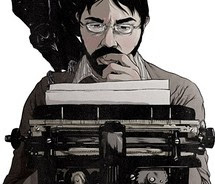Is it based in personal experience? The materialization of a long-held dream? Did the story kind of write itself? Or, was it simply an epiphany?
Well... kinda, yes, yes, and kinda.
My novel, HIDING BEHIND THUNDER, grew from the seeds of another project, itself the result of a 30-year dream. It started with a car. And my wife.
Pictured above is my 1964 Ford Galaxie that I built as a tribute to NASCAR legend Fireball Roberts. The car is a (barely) street-legal recognition of NASCAR's tumultuous Golden Age, driven (never trailered) to car shows and events near my home town. The car was the realization of a long-held dream, itself based upon witnessing cars kind of like this in the mid-1970s and beyond.
How "The Dream" of "The Car" began
Pretty much since I started walking, I've been a fan of stock car racing, and in the NASCAR Grand National Series in particular. A little over 30 years ago, I was walking back to my job when David Pearson's 1975 #21 Wood Brothers / Purolator Mercury drove right by me on the street!
Well, despite my surprise, I was still pretty confident that it was NOT the REAL car. But I still thought it was pretty cool. I mean, imagine driving what was essentially a race car on the street! It would be a while before I would learn about these promotional cars and how they were simply a factory vehicle with lookalike paint schemes and graphics. Still, I thought it pretty awesome!
Over the next couple years I would also chance upon a Gatorade Olds and later a Skoal Oldsmobile. But, like the Mercury I had seen earlier, they were simply flashy street cars. Sure, I wanted one of my own, but as the dream grew, I also wanted it to be a little different.
Enter "Project Fireball"
Fact is, I really didn't start out intending to build Fireball Roberts' old car. For nearly 15 years I tried to talk my Uncle Ronnie out of his old metallic blue '64 Galaxie that had sat idle in a mass of weeds on his horse property gathering layers of dust and serving as a community housing project for field mice, wasps and black widows. My hope had been to turn that particular car into a replica of Ned Jarrett's 1964 #11 Bondy-Long car simply through fresh paint and decals, in the same vein as the promo cars I has seen in the past. It never happened, but the dream was never forgotten.
Then, in 2006 I came upon an eBay auction for a '64 Galaxie, located in Fresno, CA, only about 170 miles south of my home. The car was the victim of an arson attempt, with a serious dose of fire and smoke damage.
I mean, what better platform for an early NASCAR replica?
Damned if I didn't get it, despite my wife's perpetual eye-rolling!
I gutted the interior, installed a roll cage, and, after removing all of the chrome, filled 161 holes in the body. But then came the task of deciding which car to re-create. Enter my wife.
As flexible as she normally is, she was just not content to see a car in our garage painted in a hue that she found offensive, or the same color as any vehicle we already owned. In frustration, I finally handed her a picture book of 1964 Galaxies raced in NASCAR. She jabbed her finger at a picture and said, "I like the purple one."
Fireball Roberts.
My wife has good taste.
The idea for the book is spawned
So, while researching the purple Galaxie, I also researched further on Fireball Roberts. And there I really learned about the man, the competitor, the athlete, the mentor to young drivers, the legend, and the tragedy. The more I delved into everything that surrounded him, the more I wanted to tell his story from the perspective of one of the young drivers he could have mentored and befriended. And from there, the story did begin to write itself.
Thanks to a dream, a car, a legend, and an understanding wife.
Please check out HIDING BEHIND THUNDER, now specially priced at Amazon.com, and available for downloads to Kindle, Nook, and many other e-readers -- even your PC -- at Smashwords.com
By the way, if you buy the e-book through Smashwords.com, they are offering a 33% discount coupon code if purchased by October 15, 2011.
Download the first 15% of the book for free to get a flavor of the story. Then, if you wish to purchase it in its entirety, enter the code TV78Z at checkout, and instead of paying the normal price of $5.99, you pay only $3.99! Not a Smashwords.com member? It’s free to sign up with no obligation!
Oh, and to read the entire story about "Project Fireball", go to CarDomain.com and check it out!






























